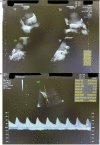Balancing Benefits and Risks of Indomethacin in the Management of Antenatal Bartter Syndrome: A Case Report
- PMID: 35847797
- PMCID: PMC9276994
- DOI: 10.3389/fmed.2022.870503
Balancing Benefits and Risks of Indomethacin in the Management of Antenatal Bartter Syndrome: A Case Report
Abstract
Background: Bartter syndrome, a very rare inherited renal tubular disorder, characterized by urinary salt wastage, hypokalemia, polyuria, and metabolic alkalosis, may manifest antenatally as severe isolated polyhydramnios. Indomethacin is known to reduce salt wastage and subsequent polyhydramnios during pregnancy; however, it reduces the Ductus Arteriosus diameter among other potential complications, such as inhibition of gastrointestinal perfusion and increasing the risk of renal toxicity.
Case: A 36-year-old multigravida presented with severe isolated polyhydramnios at 30 weeks of gestation. Based on a history of a previous pregnancy affected with Bartter syndrome, indomethacin was initiated. Amniotic fluid volume and Ductus Arteriosus diameter were monitored. As evidence lacks on optimal dose and duration of indomethacin, multiple-dose adjustments were made to reduce the amniotic fluid volume while maintaining normal Ductus Arteriosus diameter. Progressive polyhydramnios led to Cesarean section at 34+ weeks of gestation resulting in a healthy fetus diagnosed with Bartter syndrome in the early neonatal period.
Conclusion: We share our experience in the adjustment of the dose and duration of Indomethacin therapy in the treatment of severe polyhydramnios associated with antenatal Bartter syndrome. Amniotic fluid index, Ductus Arteriosus diameter, and umbilical artery doppler work together as key indicators to guide the success and safety of the therapy.
Keywords: Bartter syndrome; Ductus Arteriosus; amniotic fluid index; indomethacin; polyhydramnios.
Copyright © 2022 Alajjuri, Samaha, Honemeyer, Mohammed and Mousa.
Conflict of interest statement
The authors declare that the research was conducted in the absence of any commercial or financial relationships that could be construed as a potential conflict of interest.
Figures





Similar articles
-
A Rare Cause of Refractory Severe Polyhydramnios: Antenatal Bartter Syndrome.Medicina (Kaunas). 2021 Mar 16;57(3):272. doi: 10.3390/medicina57030272. Medicina (Kaunas). 2021. PMID: 33809664 Free PMC article.
-
Antenatal Bartter syndrome: a rare cause of unexplained severe polyhydramnios.Ann Trop Paediatr. 2011;31(2):153-7. doi: 10.1179/1465328111Y.0000000006. Ann Trop Paediatr. 2011. PMID: 21575321
-
Prenatal diagnosis of Bartter syndrome: amniotic fluid aldosterone.Ann Biol Clin (Paris). 2017 Apr 1;75(2):204-208. doi: 10.1684/abc.2017.1229. Ann Biol Clin (Paris). 2017. PMID: 28377333 English.
-
Bartter syndrome: An infrequent tubulopathy of prenatal onset.Rev Chil Pediatr. 2019 Aug;90(4):437-442. doi: 10.32641/rchped.v90i4.932. Rev Chil Pediatr. 2019. PMID: 31859717 Review. English, Spanish.
-
Fetal umbilical vein thrombosis associated with fetal bartter syndrome: an unusual case report and literature review.BMC Pregnancy Childbirth. 2025 Mar 29;25(1):371. doi: 10.1186/s12884-025-07496-1. BMC Pregnancy Childbirth. 2025. PMID: 40158156 Free PMC article. Review.
Cited by
-
Bartter Syndrome Presenting as Arginine-Vasopressin Resistance: A Report of 2 Cases.Am J Case Rep. 2024 Jun 17;25:e942872. doi: 10.12659/AJCR.942872. Am J Case Rep. 2024. PMID: 38885190 Free PMC article.
References
-
- Hallak M, Kirshon B, Smith EO, Cotton DB. Amniotic fluid index. Gestational age-specific values for normal human pregnancy. J Reproduct Med. (1993) 38:853–6. - PubMed
Publication types
LinkOut - more resources
Full Text Sources
Research Materials

